trenchless people
 This week we bring you the second installment in the latest NASTT blog series featuring the 2020 Argent Memorial Scholarship winner essays.
This week we bring you the second installment in the latest NASTT blog series featuring the 2020 Argent Memorial Scholarship winner essays.
One of the requirements to apply for a student scholarship from NASTT is to write an essay on the state of the trenchless industry and what the student sees for them self in the future within the industry.
Kyle LaRose of Oklahoma State University was awarded a $5,000 scholarship.
The trenchless technology industry offers a very diverse set of opportunities for students and professionals in many different areas. Whether a construction project in a metropolitan area that uses microtunneling to install or upgrading utility lines or a drilling operator in West Texas running a system which locates the next oil deposit for consumption, trenchless technology will always be a growing field. No matter what industry you are in, the building industry or the oil and natural gas industry it is a very common practice to use different trenchless technologies to further the advancement of infrastructure operations across the world. Without the multitude of different technologies and techniques, more issues would be created instead of solved.
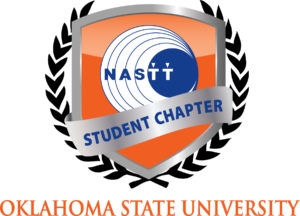 While growing up in the industry has given me many skills and assets needed to be successful in my professional career, though I still have much to learn. I believe with my degree in Construction Engineering & Technology at Oklahoma State University as well as work experience will always be exposed to trenchless technologies and what it has to offer. The construction industry is constantly improving and expanding, not only in every state across the U.S., but across the globe. Picturing myself 5 years in the future if difficult, but not impossible. Once graduation comes and I commission as an Army National Guard Officer in Horizontal Engineering, I will be established with a company and planning training exercises with my military unit all at the same time. As for the company that I am with, only time can tell.
While growing up in the industry has given me many skills and assets needed to be successful in my professional career, though I still have much to learn. I believe with my degree in Construction Engineering & Technology at Oklahoma State University as well as work experience will always be exposed to trenchless technologies and what it has to offer. The construction industry is constantly improving and expanding, not only in every state across the U.S., but across the globe. Picturing myself 5 years in the future if difficult, but not impossible. Once graduation comes and I commission as an Army National Guard Officer in Horizontal Engineering, I will be established with a company and planning training exercises with my military unit all at the same time. As for the company that I am with, only time can tell.
Though I plan to be an officer in the military, I will also pursue my civilian career in the construction industry. I chose being a Horizontal Engineering Officer because I wanted my military and civilian jobs to build off each other. I am constantly trying to learn skills needed to be the best construction manager in the industry and what better way to do that than be a part of the military as well as work in the civilian market. I believe that being a part of the military has taught me many skills needed to be a professional within the industry such as my leadership skills and heightened my verbal communication skills. I am extremely excited to see what my future has in store for me, but only I am the one that sets limitations on my progression within the construction industries which include commercial, trenchless and heavy civil.
Congratulations Kyle! We thank you for your military service and best of luck on your future endeavors in the trenchless industry!
trenchless people
 We are pleased to bring you the first installment in the latest NASTT blog series featuring the 2020 Argent Memorial Scholarship winner essays.
We are pleased to bring you the first installment in the latest NASTT blog series featuring the 2020 Argent Memorial Scholarship winner essays.
One of the requirements to apply for a student scholarship from NASTT is to write an essay on the state of the trenchless industry and what the student sees for them self in the future within the industry.
Josiah Dehnke of Kent State University was awarded a $5,000 scholarship.
The rapid growth of the trenchless industry comes at a pivotal time for the underground infrastructure in the United States. The 2017 ASCE report card graded drinking water, wastewater, and energy all a D+ or lower. A large portion of our underground utilities are in desperate need of repairs, rehabilitation and replacement. Although this underground infrastructure is the primary carrier of drinking water, wastewater, gas, oil, and power, it is also widely overlooked. This is the epitome of “Out of sight, out of mind”.
 Luckily, as trenchless technology continues to grow, so does the opportunity to begin a career in the field of trenchless and help ensure the bright future of our civilization and its prosperity. From rehabilitation to new installation, the opportunities in this rapidly growing industry are endless. Not only is trenchless technology the most cost and time effective option, but it is also far superior in terms of intrusion and environmental concerns. As the emphasis on minimal environmental impact continues to grow, so do the benefits of trenchless.
Luckily, as trenchless technology continues to grow, so does the opportunity to begin a career in the field of trenchless and help ensure the bright future of our civilization and its prosperity. From rehabilitation to new installation, the opportunities in this rapidly growing industry are endless. Not only is trenchless technology the most cost and time effective option, but it is also far superior in terms of intrusion and environmental concerns. As the emphasis on minimal environmental impact continues to grow, so do the benefits of trenchless.
The trenchless industry is a great opportunity for students such as myself looking to get into a unique and ever changing career upon graduation. Because our underground infrastructure is the carrier of every type of commodity, this creates a wide variety of opportunities in the electric, wastewater, drinking water, and oil and gas industries. Within those industries, a project manager or engineer could be involved in rehabilitation, new install or repairs.
Becoming a part of this industry would also provide opportunities to travel all over North America and possibly the world. These possibilities are some of the many reasons why I am looking forward to attending my first NASTT No-Dig Show in Denver. Upon deciding to pursue a concentration in Civil Construction, my first class was Civil Utilities and my professor largely covered trenchless technology. Upon beginning the coursework, I instantly became interested in the industry and wanted to learn more. A few months into the semester, our NASTT student chapter was lucky enough to have Bernie Krzys on campus for a speaking event. Hearing Mr. Krzys speak as well as having a conversation with him about the ever-expanding industry and the developing technology in the trenchless community made me eager to learn more.
I’m hoping to have some networking opportunities at the No-Dig show that may lead to employment opportunities with some of the most respected contractors in the country. This industry’s diverse and unique opportunities truly intrigue me. I chose to be a part of the civil construction industry because of the opportunity to directly improve our infrastructure and wellbeing; being able to be a part of a unique and environmentally sound community such as trenchless technologies would make my career choice even more fulfilling.
Congratulations Josiah and best of luck on your future endeavors in the trenchless industry!
Industry News, trenchless people
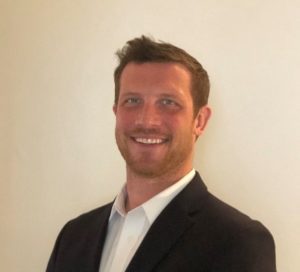 Philadelphia PA – Pipe Lining Supply is pleased to announce the recent hire of Steve Maszczak to the position of Technical Representative serving the Northeastern USA.
Philadelphia PA – Pipe Lining Supply is pleased to announce the recent hire of Steve Maszczak to the position of Technical Representative serving the Northeastern USA.
Steve brings over 10+ years of CIPP experience to Pipe Lining Supply. This experience started as a CIPP technician, moved to a CIPP foreman, and the last 7 years as sales and project management. “With Steve’s extensive background of CIPP along with his sales/project management skills, he was an excellent candidate to grow our presence in the Northeast region.” states owner John Heisler.
Steve will support Pipe Lining Supply’s customer base with training, advice, and sales for CIPP lateral lining and AIPPR pipe coating projects for drain, waste, and vent in Pennsylvania and surrounding states.
Pipe Lining Supply is a leader in the manufacturing and distribution of materials and equipment used in the lateral sewer lining and DWV rehabilitation business. The company was formed to support customers who need training and support as well as the equipment and materials to rehabilitate aging sewer laterals and pipe to restore your pipes to LIKE new condition, extending pipe life 50+ years!
Our goal is to serve the industry with a complete warehouse stocked with the best products at the lowest delivered cost on a timely basis.
CONTACT:
Pipe Lining Supply, Corp.
Michelle Strasburg
Director of Marketing
888-354-6464
www.pipeliningsupply.com
Industry News, trenchless people
 As a recognition for long-term involvement in the International Society for Trenchless Technology (ISTT) and technical or professional contributions to the ISTT, the ISTT Board has created the membership grade of ISTT Fellow. For an ISTT Member to apply (or to be considered) to become an ISTT Fellow, the Member must meet all of the following criteria:
As a recognition for long-term involvement in the International Society for Trenchless Technology (ISTT) and technical or professional contributions to the ISTT, the ISTT Board has created the membership grade of ISTT Fellow. For an ISTT Member to apply (or to be considered) to become an ISTT Fellow, the Member must meet all of the following criteria:
- Have been an ISTT member (or worked for a company holding an ISTT Corporate Membership) for a cumulative total of at least 15 years (gaps in membership are permitted and membership can either have been through an ISTT Member Society or as an International Member in the case that there was/is no ISTT Society).
- Have registered for and attended at least 12 International No Dig Conferences (exhibit only or 1-day registrations are not counted as full attendance).
- Had a minimum of 5 technical papers included in ISTT Conference Proceedings.
An ISTT Member wishing to be considered to be named an ISTT Fellow should submit an application to the ISTT Executive Director BY 30 JUNE 2020 providing:
Name, address, email address, phone number.
- Half- to one-page biosketch.
- A list of the years of ISTT membership with Affiliated Society name, category of membership (i.e., as an individual or under a corporate membership), and corporate membership name if pertinent.
- A list of the ISTT International No Dig Conferences attended as a full registered participant.
- Citation information for the papers published in ISTT Conference Proceedings.
- A list of the years of services and position with Affiliated Society.
Once the ISTT has verified the data submitted, the candidate’s name will be considered by a special review committee. Applications that are sent forward by the review committee will then be examined by the ISTT Executive Subcommittee before the final decision is made. The granting of Fellow status is based on significant accomplishments in the field of trenchless technology as demonstrated, for example, by work experience, by publications, by inventions, by technology advancements, or by mentoring of individuals.
The special review committee is also empowered to make its own nominations for ISTT Fellow in special cases where an individual has made notable technical and/or professional contributions to the ISTT over a long period of time but does not meet specific aspects of the standard eligibility criteria.
When approved, the individual will be entitled to refer to themselves as “ISTT Fellow” or “Fellow of the International Society for Trenchless Technology” and will receive a certificate confirming their status as ISTT Fellow. The ISTT Fellow designation is a continuing recognition but, to retain the ISTT Fellow designation, the person in question must remain an ISTT member in good standing either as an individual member or under a Corporate Membership. Once an ISTT Fellow status has lapsed, the individual will still be able to list the former status as ISTT Fellow with the years that the status was held.
To apply to be reinstated as an ISTT Fellow, a letter requesting a reevaluation should be submitted to the ISTT Executive Director, Peter Smeallie, at smeallie@istt.com.
Industry News, trenchless products
 March 10, 2020 – LAKE MILLS, Wisc. – HammerHead® Trenchless, a leading manufacturer of trenchless installation, rehabilitation, and replacement solutions for underground utility infrastructure, today announced a new addition to its award-winning line of Same Path™ technology: the NEW SLX1300 trenchless pipe extraction system for small diameter steel natural gas services.
March 10, 2020 – LAKE MILLS, Wisc. – HammerHead® Trenchless, a leading manufacturer of trenchless installation, rehabilitation, and replacement solutions for underground utility infrastructure, today announced a new addition to its award-winning line of Same Path™ technology: the NEW SLX1300 trenchless pipe extraction system for small diameter steel natural gas services.
Pipe extraction using the patented SLX1300 is an innovative new method of replacing coated and bare steel gas service lines 0.5 to 1.25 inches in diameter, up to 100 feet in length. The hydraulically powered SLX1300 unit produces up to 13.3 tons of pulling force to extract the pipe from the ground while simultaneously pulling new HDPE or MDPE pipe into the same location as the existing pipe, reducing risk to surrounding utilities.
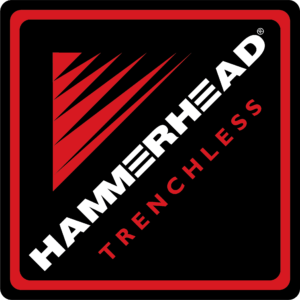
“HammerHead has a strong track record of working closely with crews in the field to find cost-effective solutions for addressing deteriorating gas pipelines,” said Josh Hood, HammerHead Trenchless senior product manager. “A gas company approached us about finding a trenchless way to replace bare steel and our engineering team applied operator feedback to design the SLX1300 to meet needs unique to the gas market. The final design includes innovative features to minimize excavation and reduce operating requirements.”
One feature is the unit’s on-board pipe shear that the operator engages to cut the pipe material as it is extracted into manageable segments for easy disposal.
The pipe extraction process requires two access points: a machine pit located where the service connects to the main, and an access point opposite the machine from which to pull in the new pipe. A cable is fed from the machine through the pipe and attached to the new pipe at the other end. The machine’s jaws clamp the steel pipe and the cable within it, and the machine is then engaged to pull the pipe from the ground. The jaws release and the machine cycles forward to clamp and pull another segment. The pipe shear located behind the machine’s clamping jaw can be engaged at the operator’s discretion to segment the extracted pipe in any length as space allows.
The compact size of the unit requires a working pit approximately 4 feet wide by 4 feet long and the entire system can be transported in the back of a standard pickup truck, reducing costs associated with extensive excavation and support equipment needs.
“The US DOT reports that there are more than 1.5 million of bare steel services still in operation in the US and the lack of a protective coating can cause the steel to corrode and deteriorate faster than other materials. Having efficient and cost-effective replacement methods for these kinds of pipes is critical,” explained Hood. “Operators across the country have observed the cost savings and benefits of trenchless construction methods so we’re proud to introduce a new trenchless technology that facilitates rapid replacement of at-risk steel gas pipes.”
The HammerHead Trenchless line of Same Path Technology also includes a patented pipe slitting system used for the trenchless replacement of plastic gas services. The SLX1300 is designed for steel pipe but preliminary field testing on additional pipe materials is underway.
The new SLX1300 pipe extraction system will be on display in the HammerHead Trenchless booth (#C31747) at the CONEXPO-CON/AGG show March 10-14 in Las Vegas, Nev.
The SLX1300 is available from HammerHead Trenchless authorized dealers in North America. Authorized dealers can be found on the web at www.hammerheadtrenchless.com or by calling 800.331.6653.
Photo: The HammerHead Trenchless SLX1300 pipe extractor offers a trenchless solution for replacing 0.5-1.25” steel gas services by extracting the steel pipe and simultaneously pulling new PE pipe into place.
Industry News, trenchless people
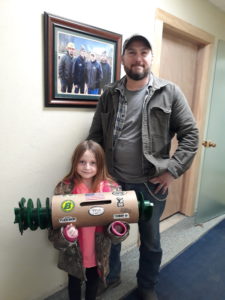
Annually, the Third Graders from East Canton Elementary School partner with area businesses to create special one of a kind Valentine’s Day card boxes. It is a great tradition that is spearheaded by Mrs. Rebecca J Carter, Principal of East Canton Elementary.
This year Third Grader Maddie Karahuta, daughter of Barbco, Inc. Maintenance Leadman, Shaun Karahuta designed an incredible box that is a miniature version of one of Barbco’s powerful, ground boring, augers!
Maddie presented this wonderful box to Barbco Co-Owner and General Manager, David Barbera recently!
This Valentine’s Day Box is proudly displayed in the Barbco, Inc. lobby!

Industry News, trenchless people
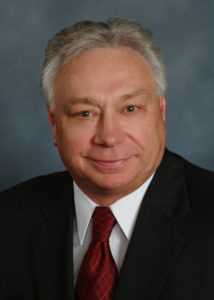 BROWNSVILLE, Wis. (April 1, 2020) — It is with profound sadness that Michels announces the passing of industry icon Robert H. Westphal on Tuesday, March 31.
BROWNSVILLE, Wis. (April 1, 2020) — It is with profound sadness that Michels announces the passing of industry icon Robert H. Westphal on Tuesday, March 31.
Bob devoted 55 years of his life to Michels, tirelessly pushing the company’s performance, and the pipeline and trenchless construction industries’ potential to higher levels. Hired by Dale Michels in April 1965 as a pipeline laborer, Bob quickly established himself as a great leader, generous mentor and valued friend to those he worked with, including the Michels family.
“It is our belief that the strength of his successors defines a leader’s true success,” said Pat Michels, President and CEO, Michels Corporation. “In that regard, Bob was the best. He was selflessly devoted to improving the abilities and skills of those who worked with him.”
“Throughout the decades, I have had the privilege of calling Bob my boss, my mentor, my colleague and my friend,” Michels said. “He had a major impact on me in each of those roles.”
In his career, Bob filled many roles, including laborer, operator, foreman, superintendent, general superintendent, vice president, senior vice president and, at the time of his death, senior construction advisor. He helped guide Michels’ development and execution of strategic business initiatives domestically and internationally.
A statesman in the construction industry, Bob was a valued member of many organizations. In 2019, he was inducted into the North American Society for Trenchless Technology (NASTT) Hall of Fame and was named Trenchless Technology Person of the Year in 2011. Bob was also an active member of the Pipe Line Contractors Association (PLCA), where he served on the Board of Directors for 13 years and as president in 2005. In 2018, he was named an Honorary Member.
Bob’s legacy will leave a significant impact on Michels and the industry he loved. We extend our thoughts and condolences to his wife, Jone; his sons Scott, Jeff, Matt and Chad; his many other family members; and his large extended family at Michels.
Industry News, trenchless products
Multiple configurations available for maximum versatility
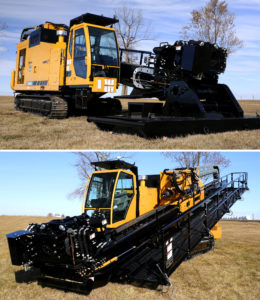 PELLA, Iowa, March 11, 2020 – Building on the success of the D220x300 S3 Navigator® horizontal directional drill (HDD), which created a new category in the HDD industry, Vermeer is setting a new standard with the D220x500 S3 Navigator® horizontal directional drill. With the ability to be configured for large-diameter water and utility installs in urban areas, as well as challenging pipeline work, the Vermeer D220x500 S3 delivers up to 54,000 foot pounds (39,828.2 Nm) of torque at a spindle speed of 36 revolutions per minute, 240,400 pounds (1069.4 kN) of thrust/pullback, and fluid flow rates of up to 350 gallons per minute (1324.9 L/min) if the onboard pump is selected. The D220x500 S3 is available with an onboard cab or stand-alone operator cab, and with a 20-foot to 30-foot (6.1-m to 9.1-m) rod rack. Contractors can also choose between a rod stager or full-length catwalk, as well as add an optional mud pump, crane or hydraulic scissor lift for optimum staging efficiency.
PELLA, Iowa, March 11, 2020 – Building on the success of the D220x300 S3 Navigator® horizontal directional drill (HDD), which created a new category in the HDD industry, Vermeer is setting a new standard with the D220x500 S3 Navigator® horizontal directional drill. With the ability to be configured for large-diameter water and utility installs in urban areas, as well as challenging pipeline work, the Vermeer D220x500 S3 delivers up to 54,000 foot pounds (39,828.2 Nm) of torque at a spindle speed of 36 revolutions per minute, 240,400 pounds (1069.4 kN) of thrust/pullback, and fluid flow rates of up to 350 gallons per minute (1324.9 L/min) if the onboard pump is selected. The D220x500 S3 is available with an onboard cab or stand-alone operator cab, and with a 20-foot to 30-foot (6.1-m to 9.1-m) rod rack. Contractors can also choose between a rod stager or full-length catwalk, as well as add an optional mud pump, crane or hydraulic scissor lift for optimum staging efficiency.
“The new D220x500 S3 integrates many of the quality features found on the Vermeer D220x300 S3 HDD, but with even more versatility and ramped-up performance,” said Tod Michael, product manager of trenchless products for Vermeer. “This drill is designed to meet the needs of utility contractors performing large-diameter city work, as well as pipeliners that are performing long, large-diameter bores.”
Choose the configuration
Outfitting the Vermeer D220x500 S3 with a 30-foot (9.1-m) rack gives crews the ability to use a variety of Range 2 drill pipe at various diameters and a range of 29 feet to 32 feet (8.3 m to 9.8 m) in length — an ideal setup for performing pipeline work. This rack configuration can be paired with a rod stager that holds four rods or a full-length catwalk. Crews will also like the benefits of using the optional hydraulic scissor lift with the rod stager to help reduce drill rod and wireline staging cycle times. Also, if paired with a stand-alone pump, the D220x500 S3, with its four 1.5-inch (3.8-cm) mudlines and 3-inch (7.6-cm) head shaft, can accommodate 650 gallons per minute (2460.5 L/min) of downhole drilling fluid flow.
For more mobile operations, the D220x500 S3 can be equipped with an on-board excavator-style cab that has a view of the open-top vises, as well as the rack and rod stager. Both the on-board and detached cab include the same dual multifunction joystick controls found on all Vermeer S3 horizontal directional drills.
Jobsite performance
The Vermeer D220x500 S3 is built with a 415-horsepower (310-kW) Cat C13 ACERT Tier 4 Final engine that is convenient to service. The drill also runs quiet at just 81.2 dB(A).
“The combination of the D220x500 S3 drill’s class-leading rotary torque and fluid pressure delivers optimized drilling and reaming performance in challenging ground conditions like rock,” added Michael. “More torque helps reduce the number of reamer passes crews need to make when widening a hole, and high fluid flow help protect tooling while maintaining the drill hole integrity and operational efficiencies.”
The D220x500 S3 also features a sliding vise that helps clamp the rod connection at different positions when reaming and pulling product, and includes a wireless remote for repositioning plus mounted cameras near the drive chuck, vise and rod handling areas for outstanding operator visibility.
For more information about the full line of pipeline horizontal directional drills, contact your local Vermeer dealer or visit vermeer.com.
Industry News, trenchless people
 CLEVELAND, OH. — With the departure of Matthew Izzard as Vice Chair of ISTT, the society’s Executive Sub-Committee (ESC) has elected Dr. Kimberlie Staheli as interim Vice Chair. Staheli currently serves on the ESC. The interim position will be in effect until the meeting of the International Council in Malaysia in November 2020 at which a new election will be held. Staheli joins Albert Shou, currently one of two Vice Chairs for ISTT.
CLEVELAND, OH. — With the departure of Matthew Izzard as Vice Chair of ISTT, the society’s Executive Sub-Committee (ESC) has elected Dr. Kimberlie Staheli as interim Vice Chair. Staheli currently serves on the ESC. The interim position will be in effect until the meeting of the International Council in Malaysia in November 2020 at which a new election will be held. Staheli joins Albert Shou, currently one of two Vice Chairs for ISTT.
Dr. Staheli stated, “I am proud and honored to be elected to the position and look forward to continuing working towards the ISTT mission of developing trenchless technology around the world.”
Kim has a B.S. in Mechanical Engineering from Rensselaer Polytechnic Institute, a M.S. in Civil Engineering from Mississippi State University and a Ph.D. in Geotechnical Engineering from Georgia Institute of Technology. She is the president and founder of Staheli Trenchless Consultants.
Kim has served as the Chair of the NASTT Board of Directors and currently serves on the NASTT No-Dig Show Program Committee. Kim teaches NASTT’s Introduction to Trenchless Technology, New Installations Short Course and NASTT’s New Installation Methods Good Practices Course. She is also part of the International No-Dig Organizing Committee for the 2022 show in Panama, representing NASTT which the society looks forward to supporting.
Craig Vandaelle, current Chair of the Board of Directors of NASTT stated, “We are delighted that Kim has been recognized in this way and shows the commitment NASTT has in supporting the ISTT family. Her knowledge and experience as Past Chair of NASTT and the Executive Committee of ISTT will be an asset to the organization.”
Blog, Industry News, trenchless projects
Tough TBM breaks through after navigating Faults, Karst, and More
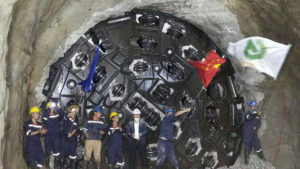 In January 2020, a Robbins 5.97 m (19.6 ft) diameter Main Beam TBM cleared its final hurdle when it broke through in Guangxi Province, China. The TBM excavated its first of two tunnels, an 11.9 km (7.4 mi) long conduit for Lot 1 of the North Line Water Irrigation Project, Letan Water Reservoir, Drought-Relief. The tunnel was marked by a gauntlet of challenges, from karst cavities to fault zones and water inflows. The workers on the jobsite, contractor Guangdong No. 2 Hydropower Bureau Co., Ltd., and the owner, Construction Management Bureau for the Letan Water Reservoir, had much to celebrate after completion of what is widely regarded as the most complex and longest tunnel on the North Line project.
In January 2020, a Robbins 5.97 m (19.6 ft) diameter Main Beam TBM cleared its final hurdle when it broke through in Guangxi Province, China. The TBM excavated its first of two tunnels, an 11.9 km (7.4 mi) long conduit for Lot 1 of the North Line Water Irrigation Project, Letan Water Reservoir, Drought-Relief. The tunnel was marked by a gauntlet of challenges, from karst cavities to fault zones and water inflows. The workers on the jobsite, contractor Guangdong No. 2 Hydropower Bureau Co., Ltd., and the owner, Construction Management Bureau for the Letan Water Reservoir, had much to celebrate after completion of what is widely regarded as the most complex and longest tunnel on the North Line project.
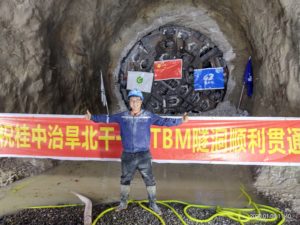 Boring with the Robbins Main Beam TBM and continuous conveyor system began in summer 2015. “There was no precedent in this province for using a Main Beam TBM to excavate a tunnel longer than 10 km. We didn’t have relevant local experience to use for reference,” explained Yongjiu Jin, Deputy Manager of the Project for contractor Guangdong No. 2 Hydropower Bureau Co., Ltd. The machine did encounter a number of difficult geological obstacles as it bored through limestone rock, but was still able to achieve advance rates up to 40 m (130 ft) per day in good ground.
Boring with the Robbins Main Beam TBM and continuous conveyor system began in summer 2015. “There was no precedent in this province for using a Main Beam TBM to excavate a tunnel longer than 10 km. We didn’t have relevant local experience to use for reference,” explained Yongjiu Jin, Deputy Manager of the Project for contractor Guangdong No. 2 Hydropower Bureau Co., Ltd. The machine did encounter a number of difficult geological obstacles as it bored through limestone rock, but was still able to achieve advance rates up to 40 m (130 ft) per day in good ground.
 Much of the geology consisted of lightly weathered limestone in rock class II to III, with some sections in class IV to V rock that required the heaviest amount of ground support, ranging from rock bolts to ring beams and mesh. “Our team encountered a coal seam, gasses in the tunnel, two large water inrushes, three fault zones up to 103 m long, 11 karst cavities, and more. In order to solve the ground problems, there were more than 160 special technical research meetings held,” said Yongjiu.
Much of the geology consisted of lightly weathered limestone in rock class II to III, with some sections in class IV to V rock that required the heaviest amount of ground support, ranging from rock bolts to ring beams and mesh. “Our team encountered a coal seam, gasses in the tunnel, two large water inrushes, three fault zones up to 103 m long, 11 karst cavities, and more. In order to solve the ground problems, there were more than 160 special technical research meetings held,” said Yongjiu.
Throughout tunneling, the contractor expressed thanks for Robbins Field Service staff. “Robbins personnel provided good technical support from equipment installation and commissioning through to tunnel completion. After the equipment was handed over to our company, they still helped us with equipment usage on our project, which makes us very satisfied with the Robbins after-sales service. Robbins really delivered: the after-sales phase was not the end of service, but the beginning of site service,” said Yongjiu.
 While the completion of the first tunnel—the longest single-heading construction on record for water tunnels in Guangxi—is a milestone, there is more to do. The Robbins machine will be inspected and relaunched to bore a second tunnel 4.2 km (2.6 mi) in length. The ground conditions are predicted to be equally challenging, but the tunneling operation has some help from ground prediction methodology. Tunnel Reflection Tomography (TRT)—consisting of ground prediction using seismic waves—is being used to detect changing conditions ahead of the TBM. The method can predict the distribution and scale of joints and fissures, allowing the crew to plan ahead.
While the completion of the first tunnel—the longest single-heading construction on record for water tunnels in Guangxi—is a milestone, there is more to do. The Robbins machine will be inspected and relaunched to bore a second tunnel 4.2 km (2.6 mi) in length. The ground conditions are predicted to be equally challenging, but the tunneling operation has some help from ground prediction methodology. Tunnel Reflection Tomography (TRT)—consisting of ground prediction using seismic waves—is being used to detect changing conditions ahead of the TBM. The method can predict the distribution and scale of joints and fissures, allowing the crew to plan ahead.
Located near Laibin City, the North Line project provides much needed drought relief using a network of tunnels totaling 29.4 km (18.3 mi). “This tunnel will realize the dream of drought control that people in Central Guangxi have had for many years. The breakthrough is the most important milestone event in this first phase of the North Line project,” said Yongjiu.
Image 1: Contractor Guangdong No. 2 Hydropower Bureau Co., Ltd., the project owner, and Robbins celebrate the January breakthrough of a Robbins Main Beam TBM.
Image 2: The 5.97 m (19.6 ft) Robbins TBM traversed fault zones, karst cavities, a coal seam, and more while achieving up to 40 m (130 ft) in one day.
Image 3: Robbins Field Service and Engineering staff played an important role in the project’s overall success. They advised the contractor and gave after-sales support throughout the difficult ground conditions.
Image 4: The Robbins Main Beam TBM bored through limestone rock, and installed a full range of ground support, from rock bolts to ring beams and wire mesh.
 This week we bring you the second installment in the latest NASTT blog series featuring the 2020 Argent Memorial Scholarship winner essays.
This week we bring you the second installment in the latest NASTT blog series featuring the 2020 Argent Memorial Scholarship winner essays. While growing up in the industry has given me many skills and assets needed to be successful in my professional career, though I still have much to learn. I believe with my degree in Construction Engineering & Technology at Oklahoma State University as well as work experience will always be exposed to trenchless technologies and what it has to offer. The construction industry is constantly improving and expanding, not only in every state across the U.S., but across the globe. Picturing myself 5 years in the future if difficult, but not impossible. Once graduation comes and I commission as an Army National Guard Officer in Horizontal Engineering, I will be established with a company and planning training exercises with my military unit all at the same time. As for the company that I am with, only time can tell.
While growing up in the industry has given me many skills and assets needed to be successful in my professional career, though I still have much to learn. I believe with my degree in Construction Engineering & Technology at Oklahoma State University as well as work experience will always be exposed to trenchless technologies and what it has to offer. The construction industry is constantly improving and expanding, not only in every state across the U.S., but across the globe. Picturing myself 5 years in the future if difficult, but not impossible. Once graduation comes and I commission as an Army National Guard Officer in Horizontal Engineering, I will be established with a company and planning training exercises with my military unit all at the same time. As for the company that I am with, only time can tell.














